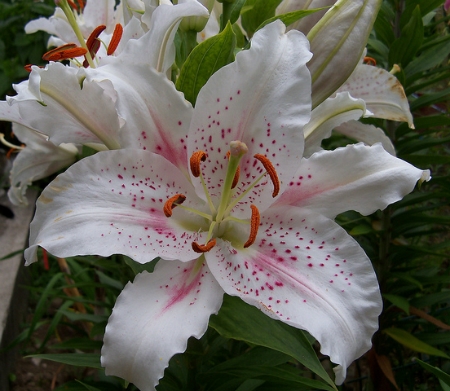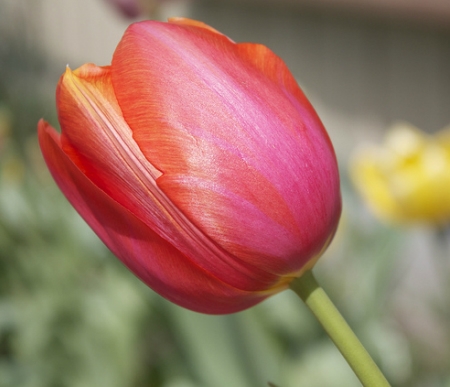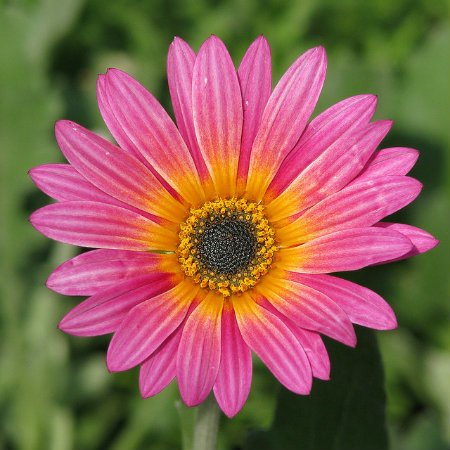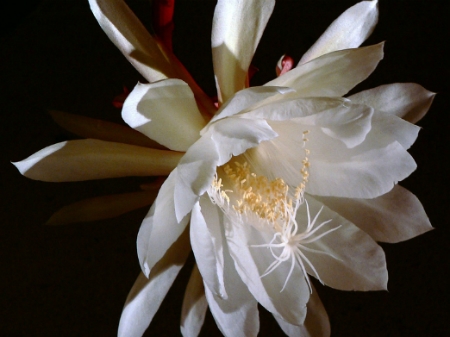





Without muscles, HOW do blossoms open and close?
My quest began after I idly clicked on a video someone had posted to Facebook. It was a National Geographic video, and combined spectacular time-lapse images of many different flowers bursting into bloom. As I watched, I noticed that some flowers slowly spiraled open, others pulsed open and closed before reaching their full spread, and yet others seemed to pop open as if exploding from the inside out. Curiosity got the best of me, and I decided to search out the mechanics of how and why!
I learned several very interesting things while trying to discover the mechanics of what causes flower petals to open, and in some cases, to open and close repeatedly. The first was probably obvious: the primary drive behind the movement of flower petals is reproduction. The end goal is fertilization, and the opening and sometimes closing of the flowers, called nastic movements, are timed to maximize the potential for pollination, and minimize the risk of damage from the weather and destructive insects.
Many factors may influence when a plant blooms. One of the major factors is daylength, or hours of sunlight. Understanding the light requirements of a plant is what allows us to force bulbs to bloom indoors in the dead of winter, using artificial patterns of dark and light to simulate dormancy and the lengthening hours of sunlight in their prime bloom season.
Weather is also a factor, and variables such as temperature, intensity of sunlight, and humidity levels may have a distinct impact on when a flower opens. Even with adequate hours of sunlight, it would do a plant no good to produce flowers if the temperatures were too cold for the pollinators to be active.
So. . .I'd learned WHY a flower opens, in response to many exterior factors, to increase the chances that a bee or other pollinator would be drawn to visit. The more complex question was HOW? If a plant has no muscles, and no conscious thought process to prompt it, what causes the petals to move so dramatically?
First, let's explore flowers that open one single time. When blooming is finished, whether it lasts for several days, or concludes after a single day, the blooms may either close again, or the petals may shrivel and fall from the plant. The opening of most flowers is caused by an inequality.
In some plants, such as lilies and iris, the borders of the petals may grow much more rapidly than the centers, or midribs, causing tension in the middle and excess tissues at the edges. This accounts for the outward curve and sometimes ruffled edges of lily petals. If you have ever sewn, and worked with a knit fabric, you understand what happens when the fabric is stretched at a diagonal. The center portion, where the fabric is pulled tight, remains smooth. The edges, where the fabric is loose, gather and ripple, similar to the wavy effect on many lily petals.

In other plants, the imbalance may come in which cells hold water, and which release it. In some flowers, the water is drawn away from the outer surfaces of the petals to the inner surfaces at bloom time, causing them to swell and push outward, often creating a distinct outwardly curving surface. As temperatures drop and daylight wanes at the end of the day, the process reverses; water is drawn outward, and the curve of the petals reverses.
Journey North gives a couple of examples of how imbalances can cause blossoms to open:
"Example 1: Imagine this. It's mid-morning. The sun has begun to warm the petals on a flower. As it does this, the pressure of the liquid inside cells at the base of the petals increases. (This is called turgor pressure.) As the cells expand and become rigid, they cause the flower to unfold.
Example 2: When light hits outer flower petals it triggers a chemical called auxin that causes cells to grow and expand. This causes to flower opens. But because its inner petals are less exposed to light, those cells remain the same and cause the flower to close once light is gone." [1]
So how do we explain the flowers that open and close more than once? Again, it is often caused by an inequality. In cup-shaped flowers that grow from a bulb, such as the crocus or the tulip, the increasing temperature at sunrise triggers the cells at the upper edges of the petals to grow rapidly in the morning, causing the flower to open wide. The allows easy access for pollinators during daylight hours when they are most active. As the daylight wanes and the temperature drops, the cells near the bottom of the petals grow more rapidly, causing the petals to draw closed. This protects the pollen from the moisture in the night air, and also gives some protection from the damaging insects that may be more active at night. If you force bulbs indoors, you may have more success if you lower your indoor temperature at night and provide a period of darkness, mimicking the conditions they would experience if grown outdoors.

Some plants depend primarily on light to trigger blooming and closing. If a flower, such as those in the daisy family, is grown in normal conditions, it will open when exposed to light, and close with darkness. Unlike some plants that will continue to open and close for several days, even if deprived of light, daisies will remain closed until exposed to light again. You may have noticed the same thing with the dandelions in your yard. They will open wide on a sunny day, but close quickly when a storm approaches and the skies become dark.

Many night-blooming flowers tend to grow in harsh environments, and remain closed during times of intense heat and low humidity. In desert areas, pollinators are more active during the night, so many plants remain tightly closed during the heat of the day. As the temperatures drop, humidity levels increase, and the nocturnal flowers open their petals. In many of these examples, such as many cactus flowers, water pressure and turgor, or distension of the plant cells by the fluid contents, are responsible for the outward curvature of the petals. As daylight and heat return, the water is drawn out of the petals and back into the plant, and the petals draw inward or curl closed again. Some only open one night of the year, like the night blooming cereus cactus, known as Queen of the Night, pictured below.

If you are interested in watching videos of flowers opening and closing, I recommend you visit YouTube and search for the work of Neil Bromhall. He has many fascinating videos that showcase many of the flowering patterns discussed in this article. Perhaps my favorite is this one, which combines videos of many different spring-blooming flowers and trees:
Neil Bromhall's Spring Flowers Time Lapse
After watching dozens of time lapse videos of flowers blooming, I've decided that my favorites are peonies. I have almost two dozen peony plants in my back yard, courtesy of the elderly gentleman who owned the property before us, and already had a soft spot in my heart for their delicate blooms. Watching them in time lapse video only increased my appreciation for them!
Thumbnail image of peony: Flickr Creative Commons, submitted by Shandie-lee Cox. Some rights reserved.
Muscadet lily: Flickr Creative Commons, submitted by Wylie. Some rights reserved.
Tulip: Flickr Creative Commons, submitted by Anne Swoboda. Some rights reserved.
African daisy: Flickr Creative Commons, submitted by Vickie DeLoach. Some rights reserved.
Queen of the Night cactus: Flickr Creative Commons, submitted by Bren Buenaluz. Some rights reserved.
[1] http://www.learner.org/jnorth/tm/tulips/OpenCloseAns.html
http://jxb.oxfordjournals.org/content/54/389/1801.full
http://www.proflowers.com/blog/how-do-flowers-open-and-close
http://www.wired.com/2011/03/flower-bloom-physics/
Copyright © www.100flowers.win Botanic Garden All Rights Reserved